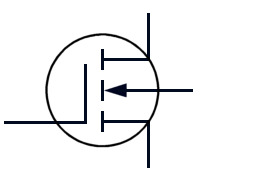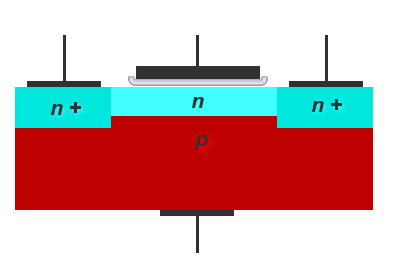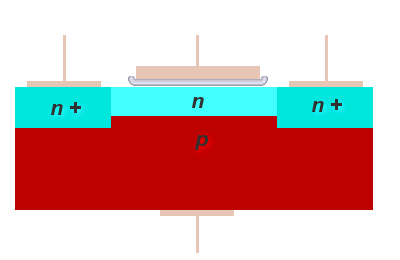MOSFET

Figure 1: MOSFET symbol

Figure 1: MOSFET symbol
A second type of field-effect transistor has been introduced that has some advantages over the JFET. This device is the Metal Oxide Semiconductor Field Effect Transistor (MOSFET). The MOSFET has an even higher input impedance than the JFET (10 to 100 million megohms). Therefore, the MOSFET is even less of a load on preceding circuits. The extremely high input impedance, combined with a high gain factor, makes the MOSFET a highly efficient input device for RF/IF amplifiers and mixers and for many types of test equipment.
The MOSFET is normally constructed so that it operates in one of two basic modes: the depletion mode or the enhancement mode. The depletion mode MOSFET has a heavily doped channel and uses reverse bias on the gate to cause a depletion of current carriers in the channel. The JFET also operates in this manner. The enhancement mode MOSFET has a lightly doped channel and uses forward bias to enhance the current carriers in the channel. A MOSFET can be constructed that will operate in either mode depending upon what type of bias is applied, thus allowing a greater range of input signals.
In addition to the two basic modes of operation, the MOSFET, like the JFET, is of either the p- channel type or the n- channel type. Each type has four elements: gate, source, drain, and substrate. The schematic symbol for an n- channel MOSFET is shown in figure 1.

Figure 2: n- channel MOSFET structure

Figure 2: n- channel MOSFET structure
The construction of an n- type MOSFET is shown in figure 2. Heavily doped n- type regions (indicated by the n+) are diffused into a p- type substrate or base. A channel of regular n- type material is diffused between the heavily doped n- type regions. A metal oxide insulating layer is then formed over the channel, and a metal gate layer is deposited over the insulating layer. There is no electrical connection between the gate and the rest of the device. This construction method results in the extremely high input impedance of the MOSFET. Another common name for the device, derived from the construction method, is the insulated gate field effect transistor (IGFET).
The operation of the MOSFET, or IGFET, is basically the same as the operation of the JFET. The current flow between the source and drain can be controlled by using either of two methods or by using a combination of the two methods. In one method the drain voltage controls the current when the gate potential is at zero volts. A voltage is applied to the gate in the second method. An electric field is formed by the gate voltage that affects the current flow in the channel by either depleting or enhancing the number of current carriers available. As previously stated, a reverse bias applied to the gate depletes the carriers, and a forward bias enhances the carriers. The polarity of the voltages required to forward or reverse bias a MOSFET depends upon whether it is of the p- channel type or the n- channel type.

Figure 3: MOSFET common source amplifier

Figure 3: MOSFET common source amplifier
